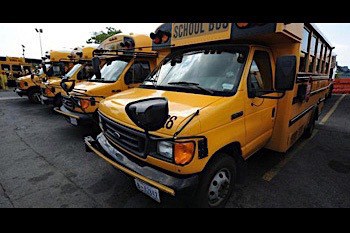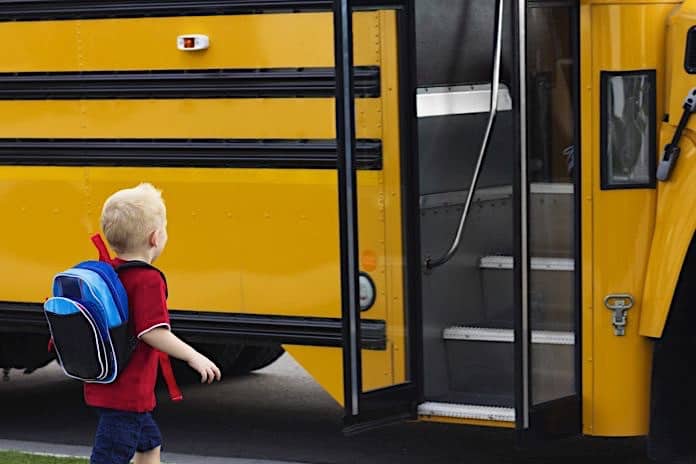NASDPTS followed up on an executive board vote in October to update its position on school bus lap-shoulder seat belts with a paper that outlines its new full support for the implementation of occupant restraint systems, as long as student ridership is not impacted.
 Not just for small buses: NASDPTS says lap/shoulder seat belts belong in all school buses, if states and local districts want them after considering all available resources. But the position is not without controversy.
Not just for small buses: NASDPTS says lap/shoulder seat belts belong in all school buses, if states and local districts want them after considering all available resources. But the position is not without controversy.
The position stands in opposition to the views held by the National Association for Pupil Transportation (NAPT) and National School Transportation Association (NSTA).
NASDPTS wrote that a “thorough consideration of available resources” should be made by states and local school districts before they decide on using the three-point systems. This includes policy training programs for proper usage, as well as adjustment and evacuation, and “unbuckle drills.” NASDPTS President Max Christensen said school buses are already the safest vehicles on the road, but “a bus can be made just a little bit safer with their installation and use.”
“NASDPTS believes this decision should be based on state or local need, but also believes lap/shoulder belt-equipped seats should be encouraged as an option when considering new bus original equipment specifications,” the association wrote in the paper. “NASDPTS further believes that states and local jurisdictions should require proper usage by all students when belts are available, and should provide related notices, training and enforcement.”
When NHTSA solicited public comments in response to its Nov. 21, 2007 Notice of Proposed Rulemaking on lap/shoulder belts in school buses, NASDPTS recommended that the feds reconsider the position that there was no need to prohibit two-point lap belts. It also called for lap/shoulder belts as “the only seat-belt system acceptable in school buses. In 2002, NASDPTS published its last position paper on the subject. Enhancing School Bus Safety and Student Transportation Safety stated the common belief then that adding three-point belts to school buses reduced the vehicles’ designated passenger capacity, which could potentially do more harm than good.
NASDPTS worried that more students would be forced to ride in unsafe vehicles on their way to and from school. National Research Council data showed that students are more safe riding to and from school in school buses, as only 0.006 percent of the student deaths each year occur in school bus crashes compared to the 99 percent of fatalities that occur in some other form of transportation, including being driven by parents or a teenager, walking or riding a bicycle.
But NASDPTS’ latest paper outlines 10 points on why it now supports lap-shoulder belts, including a 2006 study by the American School Bus Council stating that parental support for school buses may in fact increase bus ridership. The association noted that the new flexible seating technology and improved seatback thickness now offered by manufacturers have essentially negated any loss in ridership. It also cited NHTSA’s approval of technical standards for equipping buses with the seat belts and how students are to use them.
Last summer, the National Transportation Safety Board voiced its concern for the usage of occupant restraints in school buses amid publishing findings from investigations into two separate school bus crashes in 2012, one in Chesterfield, N.J., and the other in Port St. Lucie, Fla. NTSB recommended that the student transportation industry develop guidelines for the next update of the National School Transportation Specifications and Procedures, which will be voted on next May at the National Congress on School Transportation (NCST) in Warrensburg, Mo. NTSB also wants to see NASDPTS, NAPT and NSTA provide their members with educational materials on lap-shoulder belts, and advise states or districts to consider “the added safety benefit when purchasing seat belt-equpped school buses.”
NASPDPTS and the School Bus Manufacturer’s Technical Council (SBMTC) answered NTSB’s recommendations in December. SBMTC reviewed the investigation and said it will also request that driver inspection of the seat-cushion latch be introduced at the NCST in May 2015. But SBMTC Chairman Ken Whisnant of Thomas Built Buses pointed out in the letter that the NTSB report provided no details on how the failure of the bottom cushion caused or contributed to passenger injuries and the bus involved in the Port St. Lucie crash was manufactured more than five years before the October 2009 final revision of FMVSS 222 by NHTSA that added the self-latching requirements to the seat cushion retention.
Meanwhile, NAPT and NSTA jointly responded in December that they will “welcome the opportunity” to work with NASDPTS on developing the new guidelines for the national specifications but declined to take up NTSB’s recommendation, saying they “cannot in good faith” advise their members on proper installation because of “significant and confliction policy differences” at the federal level. They also said their members question if updating the federally mandated school-bus engineering design called compartmentalization might prove to be a more viable or better solution than three-point belts in side impact and rollover crashes. While offering to meet with NTSB to further discuss the issue, the associations pointed out in their letter that NHTSA “has repeatedly come to the conclusion that safety belt mandates for large school buses are inadvisable and could actually be counterproductive to improving safety.”
“We continue to believe that consideration of an upgrade to the existing design of school bus passenger crash protection should be a worthy area of federal investigation before urging the installation and usage education of seat belts, when comprehensive testing of this passive technology in side, oblique and rollover crashes has not been done to validate performance,” NAPT and NSTA wrote. “We believe it is logical to at least do the requisite research to see if enhancing compartmentalization to provide better protection during side and rollover crashes might not be the best practice to augment the good performance in frontal crashes and further improve the safety of school bus occupants.”
Mike Martin, executive director of NAPT, added that NTSB Chairman Deborah Hersman responded to the joint letter on Dec. 19 asking for a meeting to “seek a path forward.”














